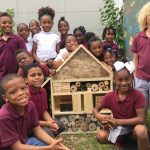28
Sep
Beyond Pesticides Launches Comprehensive K-5 Pollinator Curriculum
(Beyond Pesticides September 28, 2016) This summer, Beyond Pesticides teamed up with The Bees Waggle to develop pollinator curriculum with the intent of making it widely available for public use. The goal of the curriculum is to provide a fun, hands-on lesson about pollinators and their importance to food production. Through the lesson, students learn about biodiversity, soil health, and the negative effects of pesticides on pollinators, while participating in a variety of activities on these issues. In addition, Beyond Pesticides will offer small grant opportunities for teachers in school districts that serve low-income students in order to offset the cost of materials and supplies required to conduct the pollinator lesson plan.
The launch of this educational program is an expansion of the classroom lessons that Beyond Pesticides’ staff and Jessica Goldstrohm, owner and head educator of The Bees Waggle, brought to District of Columbia Public Schools (DCPS) this June as part of the lead up to National Pollinator Week. The education team visited two first-grade DCPS classrooms, where students participated in lessons outlined in Beyond Pesticides’ pollinator curriculum. Students gained a deeper understanding of the issues facing honey bees and other pollinators, and learned about ways they and their families can help stop pollinator decline. The students built small bee houses to take home, helping to spread pollinator friendly habitat throughout Washington, DC neighborhoods.
The Curriculum
The Pollinator Curriculum features many different elements, including several hands-on activities, all of which are designed to help students use critical thinking to draw connections between pollinators and themselves.
It starts with a LESSON PLAN designed to give teachers background information on the topic of pollinators and biodiversity, and the crucial role they play in food production. The lesson plan coordinates with a pre-designed POWERPOINT presentation, which can be used as a visual tool for students and teachers. Educators can feel free to add or delete slides depending on their scholars’ grade, age, and ability level, in order to make a presentation that is exciting and accessible to all learners.
Finally, teachers will download and print the lesson activities, which include the POLLINATOR POSTER, biodiversity web, POLLINATOR PUZZLE, and instructions for making BEE HOUSES, designed by Ms. Goldstrohm, for the students to build and take home. Teachers download and distribute a STUDENT ACTIVITY SHEET as a take-home activity, along with the PARENT INFORMATION SHEET that shares with parents the lesson their child participated in and how they can get involved as a family to help protect pollinators. Also provided are resources on BACKYARD BEEKEEPING and building a NATIVE BEE HOUSE that can be added to schoolyards or gardena in order to create additional pollinator habitat
Educating local school children is just one of the many ways that Beyond Pesticides works to protect pollinators. By teaching children about the importance of bees and other pollinators early in life, the curriculum instills the understanding that bees are helpful organisms in the larger food system, as opposed to ”˜scary’ insects. Beyond Pesticides believes this knowledge will remain with the children as they grow older, creating a new generation of adults who fully understand the importance of biodiversity and the negative impacts pesticides have on our ecosystem. To view and download the Pollinator Curriculum, click here. Be sure to email [email protected] to Beyond Pesticides know if you used this lesson with your students!
Grant Opportunities
In order to facilitate the adoption of this curriculum in school districts and classrooms that serve low-income communities, Beyond Pesticides is offering “Materials Grants” to enable teachers who wish to conduct the pollinator lesson, but may not have the resources for the supplies. To take advantage of this grant program, please fill out the online APPLICATION for more details.
For more information on what you can do to protect pollinators, see www.beeprotective.org.
















